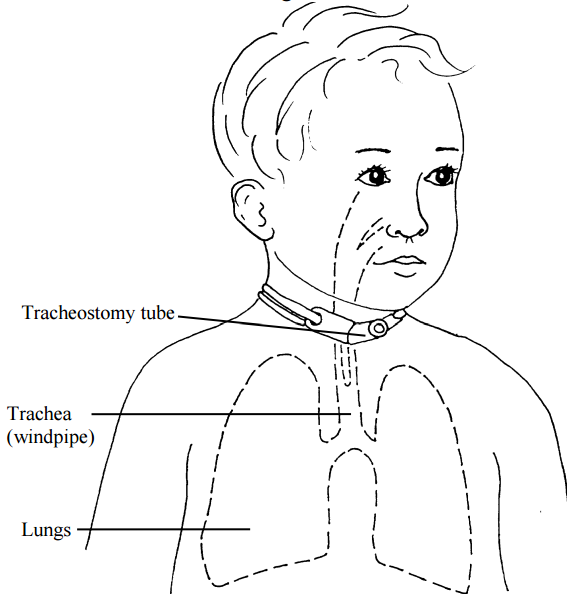Tracheostomy: Pre-operative information
What is a tracheostomy?
A tracheostomy (tray-kee-ah-stoh-mee, or "trach,") is a surgical opening made in the front of the neck into the trachea (tray-kee-ah), or windpipe. A special soft tube called a tracheostomy tube is placed in this opening to help your child breathe. The tube does not reach into the lungs.

A child might need a trach because of a birth defect, injured trachea, to assist with breathing, or other factors that prevent normal breathing through the nose and mouth. Some children only need it temporarily; how long depends on the reason it is needed. Please ask the doctor if you have questions about this.
What can I expect after surgery?
With a tracheostomy, the child breathes through the trach tube instead of the nose and mouth. At first you may not be able to hear your child cry or talk with the tracheostomy tube in place, because the breath does not pass through the vocal cords. However, most children can learn to talk with a tracheostomy tube. A speech therapist can help.
For a few days after surgery it is normal to have some bleeding around or inside the stoma (stow-ma), the opening in the neck. There will be stitches on each side of the stoma, taped to the chest, to keep the stoma open in case the tube comes out or needs changing.
Our nose and mouth keep the air we breathe moist and warm, and filter out germs that can cause infection. With a trach, the air your child breathes will need to be moistened and warmed.
Your child's cough may not be strong enough to keep the airway clear of mucus. The health care team will suction the trach tube to remove mucus and make it easier for your child to breathe.
The nurses will also clean the skin around the stoma to prevent infection.
How can I care for my child?
Some children go home with a tracheostomy tube. If your child needs to do this, the health care team will provide you and other caregivers with all the training you will need.
Education will include:
- cleaning and caring for the trach
- how to use the home care equipment (taught by the equipment company)
- assessing your child's health
- when to call the doctor
- emergency procedures and CPR for a child with a trach
- special considerations for family life
Some tasks must be done several times a day, others several times a week. Being well organized and following a schedule are important.
There are many details to learn, but the tasks will get easier as you become used to them. We want you to feel comfortable doing
these procedures before you take your child home.
With time, children with trachs can do most things other children do.
Questions?
This sheet is not specific to your child but provides general information. If you have any questions, please ask the doctor.
Children's Hospitals and Clinics of Minnesota
Patient/Family Education
2525 Chicago Avenue South
Minneapolis, MN 55404
Last reviewed 8/2015 ©Copyright
This page is not specific to your child, but provides general information on the topic above. If you have any questions, please call your clinic. For more reading material about this and other health topics, please call or visit Children's Minnesota Family Resource Center library, or visit www.childrensmn.org/educationmaterials.
© 2024 Children's Minnesota
